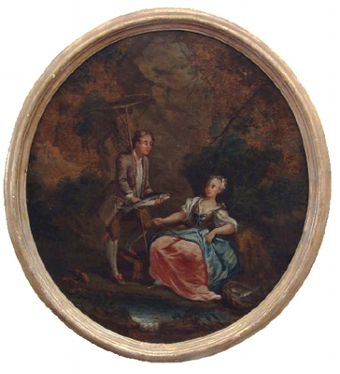featured item

quality pair of antique edwardian postal scales and weights Read more
a vintner sampling wine in a goblet from an oak cask
- View other items in:
- antiques interior design modern and vintage
- other interior design
artware ltd
Enquire about this antique
Artware Ltd has 565 antiques for sale.
click here to see them all
frame size "36 x 30"
The use of oak in wine plays a significant role in winemaking and can have a profound effect on the resulting wine, affecting the color, flavor, tannin profile and texture of the wine. Oak can come into contact with wine in the form of a barrel during the fermentation or aging periods. It can be introduced to the wine in the form of free-floating oak chips or as wood staves (or sticks) added to wine in a fermentation vessel like stainless steel. Oak introduced in the form of a wine barrel can impart other qualities to the wine through the process of evaporation and low level exposure to oxygen. In early wine history, the amphora was the vessel of choice for the storage and transportation of wine. Due to the perishable nature of wood material it is difficult to trace the usage of barrels in history. The Greek historian Herodotus noted that ancient Mesopotamians used barrels made of palm wood to transport wine along the Euphrates. Palm is a difficult material to bend and fashion into barrels, however, and wine merchants in different regions experimented with different wood styles to find a better wood source. The use of oak has been prevalent in winemaking for at least two millennia, first coming into widespread use during the Roman empire. In time, winemakers discovered that beyond just storage convenience that wine kept in oak barrels took on properties that improved the wine by making it softer and in some cases better-tasting.
The porous nature of an oak barrel allows some levels of evaporation and oxygenation to occur in wine but typically not at levels that would cause oxidation or spoilage of the wine. In a year, the typical 59-gallon barrel can lose anywhere from 5 1/2 to 6 1/2 gallons of wine through the course of evaporation. This evaporation (of mostly alcohol and water) allows the wine to concentrate its flavor and aroma compounds. Small amounts of oxygen are allowed to pass through the barrel and acts as a softening agent upon the tannins of the wine. The chemical properties of oak itself can have a profound effect on the wine. Phenols within the wood interact with the wine to produce vanilla type flavors and can give the impression of tea notes or sweetness. The degree of "toast" on the barrel can also impart different properties affecting the tannin levels of the wine as well as the aggressive wood flavors.The hydrolyzable tannins present in wood, known as ellagitannins, are derived from lignin structures in the wood. They help protect the wine from oxidation and reduction. Oak barrel aging sherry. It has a transparent front for people to see the process insideWines can be barrel fermented in oak or they can be placed in oak after fermentation for a period of aging or maturation. Wine that is matured in oak receives more of the oak flavors and properties than wine that is fermented in oak. This is because yeast cells interact with and "latch on" to the oak components. When the dead yeast cells are removed from the wine as lees some of these oak properties go with them. A characteristic of white wines that are fermented in oak include a pale color with an extra silky texture. White wines that are fermented in steel and then matured in oak will have a darker coloring due to the heavy phenolic compounds that are still present. Flavor notes that are common descriptions of wines exposed to oak include caramel, cream, smoke, spice and vanilla. Chardonnay is a variety that has very distinct flavor profiles when fermented in oak that include coconut, cinnamon and cloves notes. The "toastiness" of the barrel can bring out varying degrees of mocha and toffee notes in red wine. The length of time that a wine spends in the barrel is dependent on the varietal and style of wine that the winemaker wishes to make. The majority of oak flavoring is imparted in the first few months that the wine is in contact with oak but a longer term exposure can affect the wine through the light aeration that the barrel allows which helps to precipitate the phenolic compounds and quickens the aging process of the wine. New World Pinot noir may spend less than a year in oak. Premium Cabernet Sauvignon may spend two years. The very tannic Nebbiolo grape may spend four or more years in oak. High end Rioja producers will sometimes age their wines up to ten years in American oak to get a desired earthy, vanilla character.
Antiques.co.uk Ref: 99XW5MJK
- Materials:
- Oil on Canvas
- Width (cm):
- 76.20 x 60.96 cm 30.00 x 24.00 ins
Artware Ltd
Artware Fine Art specialises in fine antique, decorative and historical portraits and topographical pictures . We cover a period from the 17th and 18th centuries through to the 19th & 20th Centuries. We have over 150 portraits in stock, which can be viewed on our web site, each historical portrait has well researched biographical information both on the sitter and the artist.
Contact details
18 La gare
51 Surrey row
London
Greater London
SE1 0BZ
UNITED KINGDOM
T: 0207 921 97904
E: greg@artwarefineart.com
W: www.artwarefineart.com











